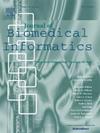表格到图像方法的迁移学习:心血管疾病预测的案例研究
IF 4.5
2区 医学
Q2 COMPUTER SCIENCE, INTERDISCIPLINARY APPLICATIONS
引用次数: 0
摘要
目的:机器学习(ML)模型已被广泛用于表格数据分类,但最近的工作已经发展到将表格数据转换为图像,旨在利用卷积神经网络(cnn)的预测性能。然而,这些方法大多不能转换样本数量少、特征类型混合的数据。本研究的目的是:评估表格数据的低混合图像生成器(LM-IGTD)的表到图像方法的性能;并评估迁移学习和微调的有效性,以提高对表格数据的预测。方法:采用Framingham和Steno两个公开的表格数据集,收集诊断为心血管疾病(cvd)的患者。首先,使用LM-IGTD将两个数据集转换成图像。然后,Framingham包含比Steno更大的样本集,用于训练基于cnn的模型。最后,我们在Steno数据集上使用预训练的CNN进行迁移学习和微调,以预测心血管疾病的风险。结果:基于cnn的迁移学习模型在Steno中获得了最高的AUCORC(0.855),优于决策树、k近邻、最小绝对收缩和选择算子(LASSO)支持向量机和TabPFN等ML模型。这种方法比表现最好的传统模型TabPFN的准确率提高了2%。结论:据我们所知,这是第一个评估使用表格到图像方法将迁移学习和微调应用于表格数据的有效性的研究。通过使用cnn的预测能力,我们的工作还通过提供早期临床干预和决策支持的框架来推进心血管疾病的诊断。本文章由计算机程序翻译,如有差异,请以英文原文为准。

Transfer learning for a tabular-to-image approach: A case study for cardiovascular disease prediction
Objective:
Machine learning (ML) models have been extensively used for tabular data classification but recent works have been developed to transform tabular data into images, aiming to leverage the predictive performance of convolutional neural networks (CNNs). However, most of these approaches fail to convert data with a low number of samples and mixed-type features. This study aims: to evaluate the performance of the tabular-to-image method named low mixed-image generator for tabular data (LM-IGTD); and to assess the effectiveness of transfer learning and fine-tuning for improving predictions on tabular data.
Methods:
We employed two public tabular datasets with patients diagnosed with cardiovascular diseases (CVDs): Framingham and Steno. First, both datasets were transformed into images using LM-IGTD. Then, Framingham, which contains a larger set of samples than Steno, is used to train CNN-based models. Finally, we performed transfer learning and fine-tuning using the pre-trained CNN on the Steno dataset to predict CVD risk.
Results:
The CNN-based model with transfer learning achieved the highest AUCORC in Steno (0.855), outperforming ML models such as decision trees, K-nearest neighbours, least absolute shrinkage and selection operator (LASSO) support vector machine and TabPFN. This approach improved accuracy by 2% over the best-performing traditional model, TabPFN.
Conclusion:
To the best of our knowledge, this is the first study that evaluates the effectiveness of applying transfer learning and fine-tuning to tabular data using tabular-to-image approaches. Through the use of CNNs’ predictive capabilities, our work also advances the diagnosis of CVD by providing a framework for early clinical intervention and decision-making support.
求助全文
通过发布文献求助,成功后即可免费获取论文全文。
去求助
来源期刊

Journal of Biomedical Informatics
医学-计算机:跨学科应用
CiteScore
8.90
自引率
6.70%
发文量
243
审稿时长
32 days
期刊介绍:
The Journal of Biomedical Informatics reflects a commitment to high-quality original research papers, reviews, and commentaries in the area of biomedical informatics methodology. Although we publish articles motivated by applications in the biomedical sciences (for example, clinical medicine, health care, population health, and translational bioinformatics), the journal emphasizes reports of new methodologies and techniques that have general applicability and that form the basis for the evolving science of biomedical informatics. Articles on medical devices; evaluations of implemented systems (including clinical trials of information technologies); or papers that provide insight into a biological process, a specific disease, or treatment options would generally be more suitable for publication in other venues. Papers on applications of signal processing and image analysis are often more suitable for biomedical engineering journals or other informatics journals, although we do publish papers that emphasize the information management and knowledge representation/modeling issues that arise in the storage and use of biological signals and images. System descriptions are welcome if they illustrate and substantiate the underlying methodology that is the principal focus of the report and an effort is made to address the generalizability and/or range of application of that methodology. Note also that, given the international nature of JBI, papers that deal with specific languages other than English, or with country-specific health systems or approaches, are acceptable for JBI only if they offer generalizable lessons that are relevant to the broad JBI readership, regardless of their country, language, culture, or health system.
 求助内容:
求助内容: 应助结果提醒方式:
应助结果提醒方式:


